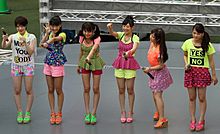Japanese idol facts for kids


In Japanese pop culture idol is a term typically used to refer to young manufactured stars/starlets marketed to be admired for their cuteness. Idols are intended to be role models. They are supposed to maintain a good public image and be good examples for young people. Idols aim to play a wide range of roles as media personalities (tarento): e.g. pop singers, panelists of variety programs, bit-part actors, models for magazines and advertisements.
The term is commercialized by Japanese talent agents. The talent agencies hold auditions for cute boys and girls and make them stars. Idols are intended to be an ideal object of love of frenzied fans. There is also a view that the Japanese people see idols as sisters or girls next door.
Japanese idol singers work across genres of the Japanese pop music. This is usually whatever is most popular at the moment. Their songs do not require great singing skills, but the artist must be beautiful, sweet and nice to sing them. In their everyday life, idols must also match the songs they sing. They must have a perfect public image and be good examples to young people.
The biggest annual idol concert festival is the Tokyo Idol Festival (TIF) held since 2010. More than 200 idol groups and about 1500 idols performed, attracting more than 80,000 spectators in 2017.
History
The phenomenon appeared in the early 1970s. It was thanks to the popularity of young French actress Sylvie Vartan and the movie she played in called Cherchez l'idole ("Look for the Idol"). The movie came out in Japan in November 1964 under the title Aidoru o Sagase. The term "idol" started being used for girls, mostly between 14 and 16, who were just beginning their path to stardom or for very young new stars.
Selective list of notable idols and idol groups
Idols with total record sales of more than 10 million
| Name | Years active | Genre | Studio albums | Sales |
|---|---|---|---|---|
| Seiko Matsuda | 1980–present (45 years) | Kayōkyoku / J-pop / Jazz | 51 | 29 million |
| Akina Nakamori | 1982–1989, 1990–2010, 2014–present (32 years) |
Kayōkyoku / J-pop | 25 | 25 million |
| Momoe Yamaguchi | 1973–1980 (8 years) | Kayōkyoku | 22 | 16 million |
| Hiromi Go | 1972–present (53 years) | Kayōkyoku / J-pop / R&B | 40 | 15 million |
| Kenji Sawada | 1967–present (58 years) | J-pop / Kayōkyoku / Glam rock | 45 | 15 million |
| Shizuka Kudo | 1987–present (37 years) | Kayōkyoku / J-pop | 17 | 14 million |
| Kyōko Koizumi | 1982–present (43 years) | Kayōkyoku / J-pop | 26 | 14 million |
| Hideki Saijo | 1972–present (53 years) | J-pop | 24 | 13 million |
| Toshihiko Tahara | 1979–present (46 years) | J-pop | 24 | 12 million |
| Masahiko Kondō | 1980–present (44 years) | J-pop / Kayōkyoku | 20 | 12 million |
| Tomomi Kahara | 1995–2006, 2013–present (17 years) | J-pop | 6 | 12 million |
Images for kids
-
AKB48 (pictured 2010) popularized stylized school uniforms as costumes.
-
Nana Mizuki (pictured 2018) was one of the first voice actors marketed as an idol.
-
Dempagumi.inc (pictured 2015) is an Akiba-kei idol group, with music and performances influenced by the otaku culture in Akihabara.
-
Perfume (pictured 2015) began as a local idol group performing in Hiroshima.
-
Sylvie Vartan (pictured 1966) is the codifier of the term "idol", after her appearance in the film Cherchez l'idole (1964) was well-received in Japan.
-
Akina Nakamori (pictured 1985) is one of the idols defining the 1980s, the Golden Age of Idols.
-
Namie Amuro (pictured 2017) saw popularity among girls in the 1990s, despite rejecting the idol label.
-
Hitomi Honda interacts with a fan at an AKB48 handshake event in 2017.
-
Minami Minegishi (pictured 2009) made international news in 2013 after a video of her with a shaved head as penance went viral. This followed news reports suggesting she was in a relationship, which led to her demotion in AKB48.
See also
 In Spanish: Idol japonés para niños
In Spanish: Idol japonés para niños














